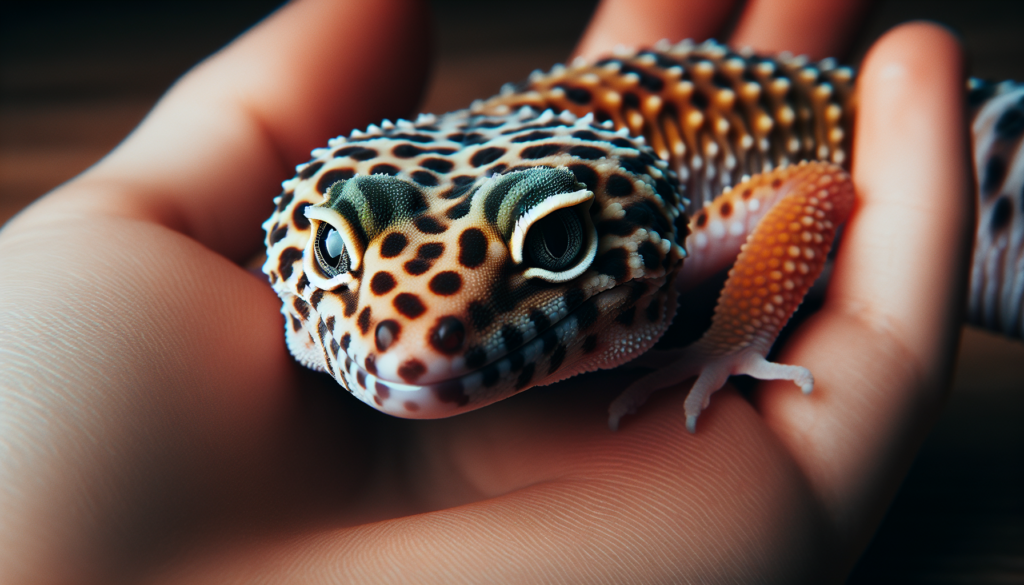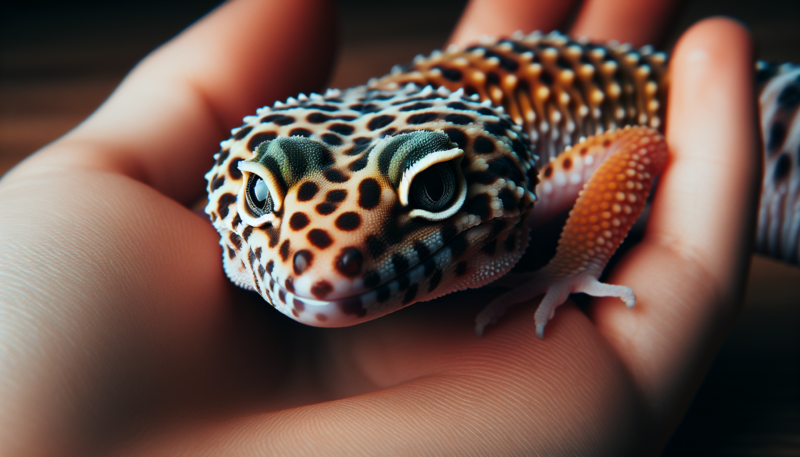Leopard geckos, the intriguing and unique reptiles, have become increasingly popular companions among pet enthusiasts. However, a common question that arises in the minds of potential owners is whether or not these geckos are comfortable with human interaction. Understanding the nature of leopard geckos and their propensity for handling is crucial in ensuring a harmonious and fulfilling relationship with these captivating creatures. While they may not exhibit the same enthusiasm for cuddles and affection as a dog, leopard geckos can indeed become accustomed to being handled, provided that certain factors are taken into consideration.

Introduction to Leopard Geckos
Leopard geckos are fascinating reptiles that make wonderful pets for reptile enthusiasts. They are native to arid regions of southern Asia, particularly Afghanistan, Pakistan, and parts of India. These geckos are known for their striking appearance, unique behaviors, and relatively docile nature. Whether you are considering getting a leopard gecko or already have one as a pet, it’s important to understand their characteristics, handling techniques, and the benefits of proper interaction.
What are Leopard Geckos?
Leopard geckos, scientifically known as Eublepharis macularius, are small to medium-sized lizards belonging to the Gekkonidae family. They typically grow to about 6 to 9 inches in length, with a broad head, sturdy body, and a long tail. One of the most distinctive features of leopard geckos is their beautiful patterned skin, which resembles the spots of a leopard, hence their name.
Appearance of Leopard Geckos
Leopard geckos come in various colors and patterns, adding to their allure as pets. They can have a base color ranging from yellow, white, or cream to shades of orange, brown, and even black. The spots on their skin can be large or small, and they often have a bumpy texture. Additionally, leopard geckos have large, lidless eyes with vertical pupils, which give them excellent night vision.
Habitat of Leopard Geckos
In the wild, leopard geckos inhabit arid and rocky regions, such as deserts and grasslands. To replicate their natural habitat, it is important to provide leopard geckos with a suitable enclosure. A well-maintained terrarium with proper heating, lighting, and substrate is crucial to their health and well-being. Leopard geckos also require hiding spots, such as caves or branches, to provide them with a sense of security and privacy.
Leopard Gecko Behavior
Understanding Leopard gecko behavior is key to promoting their welfare and establishing a strong bond with these reptiles. By observing their natural behavior patterns and engaging in proper taming and socialization techniques, you can ensure a positive and enriching experience for both you and your gecko.
Natural Behavior Patterns
Leopard geckos exhibit a variety of interesting behaviors that are necessary for their survival in the wild. They are primarily crepuscular, meaning they are most active during dawn and dusk. Leopard geckos are skilled hunters, using their sharp vision and keen sense of smell to locate and catch their prey. Additionally, they are able to shed their tail as a defense mechanism when threatened, which can later regenerate.
Taming and Domestication
Taming leopard geckos requires patience and consistency. When handling them, it is important to remember that they are still semi-wild animals and may need time to adjust to human interaction. Start by allowing them to become accustomed to your presence and gradually introduce gentle handling. Over time, they can become comfortable with being held and may even enjoy human interaction.
Social Interaction
While leopard geckos are not naturally social animals, they can still benefit from gentle socialization. By regularly handling them and providing positive experiences, you can help your gecko become more comfortable with human presence. It is important to respect their boundaries and not force interaction if they show signs of discomfort or stress.
Benefits of Handling Leopard Geckos
Handling leopard geckos can provide a multitude of benefits for both the owner and the gecko. By building trust, bonding, and regularly examining your gecko, you can contribute to their overall well-being and create a stronger human-gecko relationship.
Building Trust with Your Gecko
Regular and gentle handling can help build trust between you and your gecko. Through positive experiences, your gecko will become more comfortable with your presence and handling, leading to a stronger bond.
Bonding and Strengthening the Relationship
Handling your leopard gecko allows for regular interaction and bonding opportunities. By spending time with your gecko, you can develop a deeper connection and understanding of their unique personality and behaviors.
Opportunity for Examination and Health Monitoring
Handling your leopard gecko provides an opportunity to examine them closely, ensuring their overall health and well-being. By regularly checking for any abnormalities or signs of illness, you can address potential health issues early on.
Understanding Leopard Gecko Response to Handling
Each leopard gecko has its own individual personality and response to handling. It is important to consider environmental factors, such as temperature, and be aware of signs of discomfort or fear that your gecko may exhibit.
Individual Personality Differences
Leopard geckos, like any other living creatures, have unique personalities. Some may be more sociable and enjoy handling, while others may prefer solitude and minimal interaction. It’s important to respect and understand your gecko’s individual personality and adjust your handling approach accordingly.
Temperature and Environmental Factors
Leopard geckos are ectothermic, meaning their body temperature is regulated by external heat sources. Extreme temperatures or improper heating in their enclosure can affect their response to handling. Make sure to provide a suitable temperature gradient within their enclosure to ensure their comfort.
Signs of Discomfort or Fear
Leopard geckos may display signs of discomfort or fear when handled improperly or introduced to new situations. These signs may include trying to escape, hissing, or tail flicking. It is crucial to recognize these signs and immediately remove any source of stress to prevent harm to your gecko.

Proper Techniques for Handling Leopard Geckos
Handling leopard geckos requires Creating a safe environment, approaching them gently and slowly, and providing proper support to their bodies. Following these techniques will help ensure the well-being of your gecko and minimize any potential stress.
Creating a Safe Handling Environment
Prepare a designated area for handling your leopard gecko, such as a tabletop or a comfortable space on the floor. Make sure the area is secure and free from any potential hazards. Remove any objects that could harm your gecko or cause them to slip or fall.
Gentle and Slow Approach
Approach your gecko calmly and slowly, allowing them to become aware of your presence. Avoid sudden movements or loud noises that may startle or stress your gecko. By approaching them gently, you are more likely to establish a positive and trusting interaction.
Supporting the Gecko’s Body
When handling your gecko, it is important to support their body properly. Use a calm and confident grip, placing one hand under their body and the other supporting their tail. This helps prevent any accidental injuries and provides your gecko with a sense of security.
Introducing Handling to Young Leopard Geckos
Young leopard geckos may require additional time and patience when it comes to handling. Gradually introducing handling, implementing positive reinforcement, and building confidence are essential for young geckos to become comfortable with human interaction.
Gradual Introduction
Start by allowing your young leopard gecko to explore their enclosure and become accustomed to their surroundings. Once they are more settled, slowly introduce short handling sessions, gradually increasing the duration over time. This gradual approach helps them develop trust and confidence.
Positive Reinforcement
Positive reinforcement plays a crucial role in introducing handling to young leopard geckos. Offer small treats or rewards when they exhibit calm behavior during handling sessions. This positive association helps them associate handling with pleasant experiences.
Building Confidence and Comfort
Building the confidence and comfort of young leopard geckos through handling requires patience and consistency. Observe their body language and behavior, allowing them to set the pace. Over time, they will become more comfortable and trusting of human interaction.
Potential Risks and Precautions
While handling leopard geckos can be rewarding, it is important to be aware of potential risks and take necessary precautions to ensure their safety and well-being.
Biting and Tail Dropping
Leopard geckos may bite if they feel threatened or stressed. It is crucial to handle them with care and avoid any sudden movements that could startle them. Additionally, they have the ability to drop their tail as a defense mechanism, so it’s important to handle them gently to prevent tail loss.
Spread of Pathogens
As with any animals, there is a potential risk of spreading pathogens during handling. It is important to practice good hygiene by washing your hands before and after handling your gecko to minimize the risk of transmitting any harmful bacteria.
Overhandling and Stress
Overhandling can potentially cause stress and discomfort for leopard geckos. It is important to balance handling sessions with rest and provide hiding spots within their enclosure for them to retreat to. Pay attention to their body language and adjust the frequency and duration of handling accordingly.
Monitoring and Responding to Gecko’s Comfort Level
It is crucial to monitor your gecko’s comfort level during handling and respond to their needs accordingly. This includes recognizing signs of stress, adjusting the frequency and duration of handling, and providing hiding spots for them to retreat to when they need a break.
Recognizing Signs of Stress
Leopard geckos may display signs of stress during handling, such as trying to escape, tail flicking, or vocalization. It is important to be attentive and responsive to these signs, immediately removing any sources of stress and allowing your gecko to return to a calm state.
Adjusting Frequency and Duration of Handling
Not all leopard geckos have the same tolerance for handling, and their comfort level may vary over time. Pay attention to their behavior and body language, and adjust the frequency and duration of handling sessions accordingly. Some geckos may prefer shorter, more frequent sessions, while others may prefer longer sessions with more time between.
Providing Hiding Spots for Retreat
Leopard geckos require hiding spots in their enclosure to retreat to when they feel overwhelmed or in need of privacy. It is important to provide multiple hiding spots, such as caves or plants, where they can feel secure during and after handling sessions.
Alternatives to Handling Leopard Geckos
While handling leopard geckos can be enjoyable and beneficial, it is important to respect their individual preferences and provide alternative ways to interact and enrich their lives.
Observing and Appreciating from a Distance
Some leopard geckos may prefer minimal handling and enjoy being observed from a distance. Take the time to simply sit near their enclosure and watch their natural behaviors. You can still appreciate their beauty and unique characteristics without direct physical interaction.
Creating an Enriching Environment
Enriching your leopard gecko’s enclosure with various hiding spots, climbing structures, and items to explore can provide mental stimulation and promote natural behaviors. This allows them to engage in meaningful activities without the need for constant handling.
Interactive Toys and Feeding Techniques
Introduce interactive toys and feeding techniques to engage your leopard gecko in a different way. This can include puzzle feeders, toy balls, or even providing live prey for them to hunt. These activities provide mental and physical stimulation while minimizing the need for regular handling.
Conclusion
Handling leopard geckos can be a rewarding and enriching experience for both the owner and the gecko. By understanding their behavior, utilizing proper handling techniques, and respecting their individual preferences, you can foster a strong human-gecko bond. Regular and gentle handling contributes to building trust, strengthening the relationship, and providing opportunities for health monitoring. Remember to always prioritize the well-being and comfort of your leopard gecko, and enjoy the rewards that come with nurturing a strong connection with these captivating reptiles.
